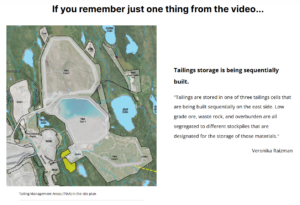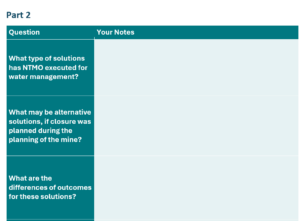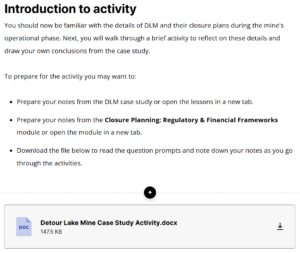Asynchronous learning opportunities for adult learners are an expanding market as more workers are looking for opportunities to upskill in a way that fits into their busy lives. Adult learners want courses that provide practical outcomes that allow them to collaborate and expand their understanding on a topic of interest. (see: Ontario Micro-Credentials: Harnessing the Potential). The Mining Industry Management Program (MIMP) courses that the ETO is developing are a great example of how collaborating with Subject Matter Experts (SME) can be a great way to bridge what has typically been on-the-job learning to the classroom. One method we have used to build practical activities that mimic on-the-job learning is practical asynchronous case studies.
Allow learners to practice real-world examples
In one of the modules of our Environment, Social, and Governance (ESG) course, Closure Planning: Case Studies, we incorporated two real world examples of closure planning that our Subject Matter Expert (SME) had firsthand experience with.
Note: Closure planning is the process of preparing for the orderly and responsible ending of a mining operation.
These case studies included actual technical diagrams and details, in addition to real closure plan demonstrative photos (e.g., real photos demonstrating the closure plans). Our SME also provided expert analysis of the closure plans through videos and external resources. Learners were then tasked with making practical decisions based on the technical information and coming to their own conclusions on the details. All details and materials were provided and curated by the SME, and the ETO organized the content into an active learning activity.

Professional education should, by design, be rooted in practical experiences (i.e., case studies). Research shows that active learning through practical examples helps learners learn faster and develop meta skills (see: What the Case Study Method Really Teaches). For example, in the workplace, workers often learn their work tasks by doing them. Practical examples like this help mimic that experience.

Intentionally add opportunities to collaborate
In our courses, we wanted to make sure there were prompts for learners to collaborate with other learners as a way to examine and synthesize their learning. When prompting reflection at the end of lessons, we often included prompts for students to share or check their understanding with colleagues or other learners. We leveraged the learners’ existing peer groups to encourage collaboration and critical thinking.
In asynchronous learning environments, building relationships between learners must be intentional. As our modules have limited ability to encourage relationship building between learners, existing relationships within the learner’s workplace or peer group were used to build collaborative learning activities. Open-ended questions also help learners consider the why of what they just learned and allow them to connect the learning to their own work.

Case studies are designed as group exercises, mimicking workplace project groups. In-depth activities may even assign roles to group members, allowing learners to experience these dynamics in a learning space. When learners investigate case studies from their own experience and with their own peer groups, they are rooted in the learner’s practical perspective.
Learners develop take-aways they can use in their future careers
Professional learners are looking for tangible takeaways that they can immediately and directly use in their jobs. In this lesson, we provided the option to download a worksheet as they navigated the case study. This tangible item can be used in their job as they navigate similar scenarios. Alternatively, they may use this resource to gather resources that they want to revisit later. These items create a touchpoint for learners to re-explore and potentially make new connections months or years in the future.

Additionally, learners can share this resource with colleagues, allowing them to teach the content to others. This can extend their understanding of the topic and create a deeper relationship with the content.
Thinking about building a case study for an asynchronous, online, or hybrid class? Or maybe you’ve already run something like this with your students? We’d love to hear from you! Reach out to the ETO to chat about how you can bring it to life using the academic toolbox and share any tips or lessons you’ve picked up from doing this kind of work in a remote setting.